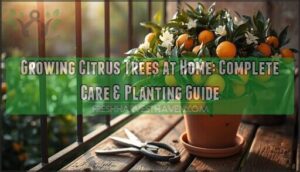This site is supported by our readers. We may earn a commission, at no cost to you, if you purchase through links.
Preparing soil for fruit garden success starts with choosing a sunny, well-draining location.
Test your soil’s pH and nutrient levels first—most fruit trees thrive in slightly acidic to neutral soil (6.0-7.0 pH).
Clear rocks and weeds, then work in 2-4 inches of compost or aged manure to improve soil structure and fertility.
Till the area 12-18 inches deep, breaking up compacted layers that could stunt root growth.
Sandy soils need organic matter for moisture retention, while clay soils require amendments like perlite for better drainage.
Create raised beds if drainage remains poor.
Your soil preparation efforts will determine whether your fruit trees merely survive or absolutely flourish with abundant harvests.
Table Of Contents
- Key Takeaways
- Choosing Location
- Soil Type Importance
- Improving Soil Quality
- Preparing Soil Structure
- Maintaining Soil Health
- Frequently Asked Questions (FAQs)
- What should I put in the hole when planting fruit trees?
- What is the best soil for fruit plants?
- What does baking soda do for fruit trees?
- How do you prepare soil for fruit?
- What is the best soil mix for fruit plants?
- How do I prepare soil for my vegetable garden?
- What do I add to soil when planting apple trees?
- How to manage pests affecting soil health?
- What plants improve soil for fruit trees?
- Can companion planting benefit fruit tree growth?
- Conclusion
Key Takeaways
- Test your soil first – Check pH levels (aim for 6.0-7.0) and nutrient content before making amendments, as this determines what your soil actually needs rather than guessing.
- Choose location wisely – Select sunny spots with 6-8 hours of direct sunlight and good drainage, creating raised beds if water doesn’t drain within six hours.
- Add organic matter generously – Work 2-4 inches of compost or aged manure into the top 12-18 inches of soil to improve structure, drainage, and nutrient retention.
- Maintain long-term soil health – Use consistent mulching (2-4 inches) and regular fertilization based on soil tests to keep your fruit trees thriving year after year.
Choosing Location
You’ll need to select the perfect spot for your fruit garden before you start digging, as location determines whether your trees thrive or struggle.
The right combination of sunlight exposure and proper drainage creates the foundation for healthy root development and abundant harvests, which is crucial for the healthy growth of your fruit garden.
Sunlight Requirements
When choosing your fruit garden location, sunlight duration becomes your secret weapon for ideal photosynthesis.
Your fruit trees crave 6-8 hours of direct sun exposure daily to fuel maximum growth and fruit production.
Consider these critical sunlight requirements for your fruit garden soil preparation:
- Tree spacing prevents neighboring plants from blocking essential rays
- Shading effects from buildings or structures reduce photosynthetic efficiency
- Seasonal sun patterns shift throughout the year, affecting consistent exposure
- Morning sunlight proves most valuable for activating photosynthesis early
Smart positioning transforms your fruit tree soil into a powerhouse production zone.
Drainage Considerations
Testing soil drainage prevents waterlogging effects and root rot that devastate fruit trees.
You’ll know you’ve got well-draining soil when water disappears within six hours of a simple percolation test.
Combat soil compaction with raised beds or French drainage solutions to boost soil aeration and improve soil drainage for thriving trees.
Consider using drip irrigation systems for efficient watering.
Soil Type Importance
Your soil type determines whether your fruit trees will thrive or merely survive in your garden.
Each soil type presents unique advantages and challenges that directly impact root development, water retention, and nutrient availability for your trees.
Loamy Soil Benefits
When you’re working with loamy soil, you’ve hit the jackpot for soil preparation.
This perfect blend of sand, silt, and clay creates ideal drainage while maintaining excellent nutrient retention for your fruit trees.
Loamy soil—the gardener’s gold standard for effortless drainage and rich nutrition.
Loamy soil is nature’s perfect blend—balancing sand, silt, and clay for thriving fruit trees and bountiful harvests.
Here’s why loamy soil delivers outstanding results:
- Root Development: Loose soil structure allows roots to spread easily and establish quickly
- Water Availability: Retains moisture without creating waterlogged conditions that harm trees
- Nutrient Retention: Holds fertilizers and organic matter longer for sustained tree feeding
- Optimal Drainage: Prevents root rot while maintaining adequate soil moisture levels
- Soil Structure: Supports healthy microbial activity and long-term garden productivity
Sandy Soil Limitations
Sandy soil presents unique challenges that’ll test your fruit gardening skills.
Water retention becomes your biggest hurdle as moisture drains away faster than roots can absorb it.
Nutrient leaching follows close behind, washing away essential minerals before trees benefit.
Amendment frequency increases dramatically—you’ll need regular soil preparation to combat these sandy soil limitations.
| Challenge | Impact |
|---|---|
| Poor Water Retention | Frequent irrigation needed |
| Nutrient Leaching | Minerals wash away quickly |
| Wind Erosion | Topsoil displacement occurs |
| Compaction Risks | Root damage from traffic |
Reorganizing the soil to address these challenges is crucial for successful fruit gardening, and understanding the complete concepts of soil management is key to overcoming the hurdles posed by sandy soil and its associated issues like nutrient leaching.
Clay Soil Challenges
Clay soil presents unique clay soil challenges that can frustrate gardeners.
Dense compaction issues prevent proper root penetration, while poor soil drainage creates waterlogged conditions.
However, clay’s excellent nutrient availability makes amendment efforts worthwhile.
Adding organic matter like compost transforms soil structure, creating drainage solutions.
These soil amendments gradually break up dense layers, improving both aeration and water movement for healthier fruit trees.
For long-term success, consider continuous organic matter additions to achieve long-term success.
Improving Soil Quality
You’ll need to improve your soil’s quality before planting fruit trees to guarantee healthy growth and maximum harvests.
Start by adding organic matter, balancing pH levels, and using compost effectively to create the ideal growing environment.
Adding Organic Matter
Once you’ve selected the right soil type, organic matter becomes your garden’s secret weapon for explosive fruit production.
This living component transforms ordinary dirt into a thriving ecosystem that feeds your trees year-round.
- Compost application – Mix 2-4 inches of finished compost into your planting area, creating a nutrient-rich foundation that boosts soil fertility while encouraging beneficial soil microorganisms to flourish.
- Manure benefits – Incorporate well-aged manure from livestock to supply nitrogen and phosphorus, improving soil structure for better water retention without causing soil erosion issues.
- Green manure – Plant nitrogen-fixing cover crops like clover or legumes between seasons, then till them under to naturally enhance your soil amendments while building long-term fertility.
Consider purchasing garden compost supplies for superior results.
Using Compost Effectively
Compost application transforms your fruit garden’s potential when done correctly.
Choose well-decomposed compost types that’ve completed their decomposition process—fresh materials can rob nitrogen from soil.
Apply 2-3 inches during spring or fall for ideal nutrient cycling.
| Compost Application Method | Benefits |
|---|---|
| Surface spreading | Feeds soil microbes gradually |
| Mixed into top 6 inches | Improves soil amendments integration |
| Around existing trees | Boosts organic matter without root damage |
Quality compost enhances soil fertility by supporting beneficial soil microbes that break down organic matter.
These microscopic workers create a thriving ecosystem that fruit trees love, improving nutrient availability year-round.
Adding organic matter also helps transform clay soil into workable earth, enhancing drainage and root growth, and minimizing mechanical disturbance.
Balancing PH Levels
Getting your soil pH right makes the difference between thriving trees and struggling saplings.
Most fruit trees flourish in slightly acidic to neutral soil, with pH levels between 6.0 and 7.0 for best nutrient uptake.
Test your soil pH using digital meters for precise readings, then adjust accordingly:
- Lime application raises acidic soil pH gradually over several months
- Sulfur application lowers alkaline soil pH for better mineral absorption
- Regular pH testing guarantees consistent soil pH balancing for maximum harvests.
Accurate readings require a reliable pH meter.
Preparing Soil Structure
Once you’ve improved your soil quality, you’ll need to create the perfect physical structure for your fruit trees’ roots to thrive.
Proper soil preparation involves tilling, aerating, and mixing amendments to give your trees the foundation they need for years of productive growth.
Tilling Techniques
Proper tilling techniques transform compacted earth into loose, workable soil for thriving fruit trees.
Rotary tilling works best at 8-12 inches tilling depth, breaking up hardpan layers that restrict roots. Hand tilling suits smaller plots, while powered equipment handles larger areas efficiently.
Till when soil crumbles in your palm—not soggy or bone-dry. No-till methods preserve beneficial microbes but require extra organic amendments.
Tilling frequency matters: one deep pass beats multiple shallow ones for soil loosening and preparing garden bed success. Many gardeners find a tilling machine helpful for larger plots.
Aeration Methods
After tilling breaks up compacted layers, you’ll want to improve oxygen flow throughout your soil.
Aeration methods create pathways for roots to breathe and water to penetrate deeper.
Try these soil aeration techniques:
- Core Aeration: Remove small plugs to relieve compaction in heavy soils
- Spike Aeration: Punch holes using garden forks for quick soil loosening
- Double-Digging Beds: Work soil to 18-24 inches deep for maximum root expansion
These aeration methods transform dense soil structure into loose, workable ground that supports healthy fruit tree development.
Healthy soil teems with living organisms and microbes, further enhancing its structure.
Mixing Amendments
Now you’ll blend your soil amendments like a master chef combining ingredients. Start with amendment ratios of 2-4 inches of organic amendments per 6 inches of existing soil depth.
Layering amendments evenly across your garden bed prevents nutrient hotspots that can burn roots. Mix these soil amendments using double-digging or rototilling techniques, working them 12-18 inches deep for ideal soil preparation.
Tool selection matters—use a garden fork for clay soils and a rototiller for larger areas. Amendment timing affects soil pH balance, so incorporate lime in fall and compost in spring.
| Amendment Type | Application Rate |
|---|---|
| Compost | 2-4 inches deep |
| Well-aged manure | 1-2 inches deep |
| Peat moss | 1 inch maximum |
| Agricultural lime | Per soil test results |
The table provides a summary of the application rates for different amendment types. By following these guidelines, you can create a well-balanced and fertile soil environment for your garden to thrive. Remember to apply compost in the spring for optimal results.
Maintaining Soil Health
Once you’ve established proper soil structure, maintaining that healthy foundation becomes your ongoing responsibility for years of productive harvests.
Your fruit trees will thrive when you consistently provide the right nutrients and protection through strategic fertilization and mulching practices.
Fertilization Strategies
Soil testing reveals your garden’s nutrient requirements—think of it as reading your soil’s wish list.
Apply fertilizer for fruit trees during late winter using balanced organic fertilizers or synthetics.
Nutrient timing matters; nitrogen fuels spring growth while potassium strengthens fruit quality.
Watch for deficiency symptoms like yellowing leaves, then adjust your fertilization strategies accordingly to maintain ideal soil fertility.
Regular foliar analysis can confirm any deficiencies for proactive management.
Mulching Benefits
While fertilization feeds your fruit trees, mulching creates the perfect growing environment around them.
Think of organic mulch as nature’s protective blanket that works overtime for your garden.
Apply a 2-4 inch layer of wood chips, straw, or shredded leaves around your trees, keeping it several inches from the trunk.
Mulch acts as nature’s protective blanket, working overtime for your fruit trees.
This simple step transforms your soil management approach:
- Moisture retention reduces watering frequency by up to 50%
- Weed suppression eliminates competition for nutrients and water
- Temperature regulation keeps roots cool in summer, warm in winter
- Nutrient enrichment occurs as mulch decomposes into valuable organic matter
Beyond these mulching benefits, you’ll notice improved soil structure and reduced soil erosion during heavy rains.
Your fruit trees will thank you with stronger growth and better harvests.
Frequently Asked Questions (FAQs)
What should I put in the hole when planting fruit trees?
Coincidentally, you’ll want to backfill with native soil mixed with compost—about 70% original dirt, 30% organic matter.
Don’t add fertilizer or amendments directly in the hole, as this creates a "bathtub effect" that restricts root growth, which is a critical consideration for complete concepts like this to ensure healthy plant development.
What is the best soil for fruit plants?
You’ll thrive with well-draining, loamy soil that’s slightly acidic to neutral (pH 0-0). Mix in compost for nutrients and structure—your trees’ roots will thank you later!
What does baking soda do for fruit trees?
You can use baking soda as a natural fungicide for fruit trees by mixing it with water and spraying leaves to combat powdery mildew and other fungal diseases effectively.
How do you prepare soil for fruit?
Test your soil’s pH and nutrients first, then mix in 2-4 inches of compost or well-rotted manure.
Choose a sunny, well-draining spot and dig planting holes twice the root ball’s width.
What is the best soil mix for fruit plants?
Like Goldilocks seeking that "just right" porridge, you’ll want loamy soil that’s perfectly balanced.
Mix equal parts compost, quality topsoil, and coarse sand with a pH between 0-0 for ideal fruit production.
How do I prepare soil for my vegetable garden?
Start by testing your soil’s pH and nutrient levels using a home kit or lab analysis.
Add compost or well-rotted manure to improve structure, then work amendments into the top 6-8 inches before planting, focusing on complete concepts to enhance your soil.
What do I add to soil when planting apple trees?
Apple trees thrive when you add 2-4 inches of compost to improve soil structure and nutrient content.
Mix in well-rotted manure for nitrogen, and adjust pH using lime or sulfur based on soil test results.
How to manage pests affecting soil health?
Soil harbors 25% of Earth’s biodiversity, yet pests threaten this foundation.
You’ll combat harmful nematodes using beneficial predator insects, encourage earthworms through composting, apply neem oil for grub control, and rotate cover crops to disrupt pest cycles naturally, utilizing beneficial methods.
What plants improve soil for fruit trees?
Legumes like clover, beans, and peas fix nitrogen naturally.
Cover crops such as crimson clover, winter rye, and buckwheat add organic matter while preventing erosion and improving soil structure for healthier fruit trees.
Can companion planting benefit fruit tree growth?
Companion planting creates a thriving ecosystem around your fruit trees.
You’ll boost soil nutrients, attract beneficial insects, and naturally suppress pests while improving pollination and overall tree health through strategic plant partnerships.
Through this method, you’ll also improve overall tree health.
Conclusion
Think of preparing soil for fruit garden success like laying the foundation for your dream home—without solid groundwork, even the most beautiful structure will eventually crumble.
You’ve learned the essential steps: choosing sunny, well-draining locations, testing pH levels, and incorporating organic amendments.
Remember to till deeply, address drainage issues with raised beds when necessary, and maintain soil health through proper fertilization and mulching.
Your diligent preparation work today directly translates to healthier trees and more abundant harvests tomorrow.



